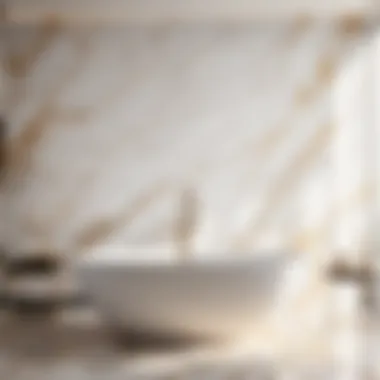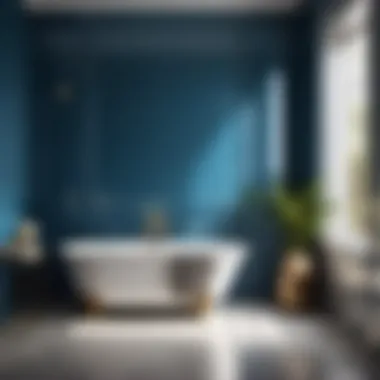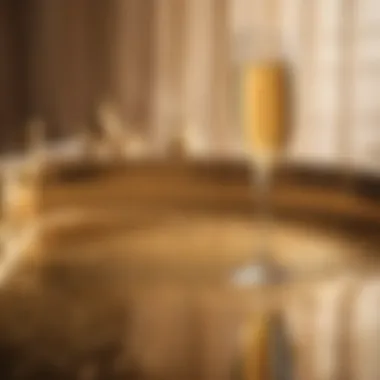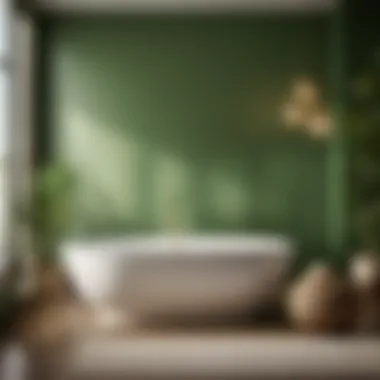Elevating Your Bathroom with the Perfect Paint Colors: A Comprehensive Guide


Materials:
- Paint primer: Ensure to use a high-quality paint primer that is suitable for bathroom applications. Measure the needed amount based on the size of your bathroom walls.
- Paint color of choice: Select a paint color that best suits your bathroom aesthetic and personal preference. Take into account the size of the space and the amount of natural light.
- Paintbrushes and rollers: Use high-quality brushes and rollers for a smooth and even application of paint.
- Painter's tape: Mask off areas that you want to protect from paint splatter, such as baseboards and trim.
- Drop cloths: Cover the bathroom floor and any fixtures with drop cloths to prevent spills and drips.
- Sandpaper: Lightly sand the walls before painting to create a smooth surface for better paint adhesion.
DIY Steps:
- Prepare Your Bathroom: Clear out the space, remove any fixtures or decor items that could obstruct painting, and clean the walls thoroughly.
- Choose the Right Paint Color: Consider the size of your bathroom, the desired ambiance, and existing elements in the space when selecting a paint color.
- Apply the Primer: Start by applying a coat of primer to ensure better adhesion and smooth paint application. Allow the primer to dry completely.
- Paint the Walls: Using a brush or roller, begin painting the walls with your chosen color. Work in small sections for precision and even coverage.
- Remove Painter's Tape: Once the paint is dry to the touch, carefully remove the painter's tape to reveal clean, sharp lines.
- Touch Up and Finish: Inspect the walls for any missed spots or imperfections. Touch up as needed and allow the paint to cure fully before rehanging fixtures or decor.
Technical Aspects:
- Timing Specifics: Allocate ample time for each step of the painting process, including drying times between coats.
- Tools: Ensure you have the necessary tools on hand, such as brushes, rollers, and sandpaper, to execute the project efficiently.
- Techniques: Use long and steady strokes when painting, starting from the top and working your way down to minimize drips.
DIY Project Process:
- Primer Application: Apply the paint primer evenly on the walls, ensuring complete coverage for a seamless paint finish.
- Paint Application: Begin painting the walls with your chosen color, making sure to spread the paint evenly and avoid buildup in corners or edges.
- Finishing Touches: After the final coat has dried, assess the walls for any touch-ups needed and make corrections as necessary for a flawless result.
Troubleshooting Tips:
- If the paint appears streaky, apply an additional coat for more even coverage.
- In case of paint drips, gently sand them off once the paint is fully dry.
- For paint bleeding under painter's tape, ensure the tape is pressed down firmly before painting.
Understanding the Impact of Paint Colors
In the realm of interior design, the importance of paint colors cannot be overstated, especially when it comes to bathrooms. The choice of color can significantly affect the ambiance, style, and overall feel of the space. Understanding the impact of paint colors is crucial in creating a harmonious and visually appealing bathroom environment that reflects your personal taste and design preferences. By delving into the psychology of colors and considering various factors, you can choose the perfect paint color that aligns with your vision for your bathroom.
Psychology of Colors in Interior Design
The influence of colors on mood and perception
When it comes to interior design, colors play a pivotal role in shaping the mood and perception of a space. Different colors evoke different emotions and can influence how individuals feel when they enter a room. For example, cool tones like blue and green are known for their calming effects, making them ideal choices for bathrooms where relaxation is key. Understanding the impact of colors on mood and perception allows homeowners to create a bathroom environment that promotes serenity and wellbeing, setting the tone for a rejuvenating experience.
Embracing color psychology for bathroom decor


Color psychology goes beyond personal preference and delves into the emotional and psychological effects of different hues. In bathroom decor, embracing color psychology can transform a mundane space into a sanctuary of tranquility or a vibrant hub of energy. By strategically incorporating colors that align with the intended ambiance of the bathroom, homeowners can enhance the overall aesthetic appeal and functionality of the space. Whether opting for calming blues or energizing yellows, leveraging color psychology in bathroom decor can elevate the sensory experience for users.
Factors to Consider When Choosing Bathroom Paint Colors
Natural lighting and its impact on color appearance
Natural lighting plays a significant role in how paint colors appear within a bathroom setting. The intensity of natural light can alter the perception of color, making it crucial to consider the amount of light that enters the space throughout the day. Opting for lighter shades in bathrooms with limited natural light can create the illusion of a more spacious environment, whereas darker tones can add depth and coziness to well-lit areas. Understanding how natural lighting impacts color appearance enables homeowners to make informed decisions when selecting paint colors for their bathrooms.
Size and layout of the bathroom space
The size and layout of the bathroom space are essential factors to consider when choosing paint colors. In smaller bathrooms, lighter hues can help visually expand the area, creating an airy and open feel. Conversely, larger bathrooms offer the versatility to experiment with bolder colors and statement shades to add personality and character. Understanding how the size and layout of the bathroom space influence color choices empowers homeowners to tailor their paint selection to enhance the overall aesthetics and functionality of the room.
Style and theme of the bathroom decor
The style and theme of the bathroom decor should harmonize with the chosen paint colors to create a cohesive and sophisticated look. Whether aiming for a minimalist, modern, or traditional design, selecting paint colors that complement the existing fixtures, fittings, and decor elements is essential for achieving a visually cohesive aesthetic. Embracing the style and theme of the bathroom decor in the paint color selection process ensures that the overall design concept is seamlessly integrated, resulting in a harmonious and aesthetically pleasing bathroom space.
Popular Paint Colors for Modern Bathrooms
In the realm of bathroom aesthetics, the selection of the right paint colors plays a crucial role in setting the tone and atmosphere of the space. When exploring popular paint colors for modern bathrooms, it is essential to consider hues that not only enhance the overall design but also create a visually appealing environment. The choice of paint colors can significantly impact the perception of space, making it appear larger, brighter, or cozier based on the selected shades.
Crisp White Shades
Pure White: A Timeless and Versatile Choice
Pure white stands out as a timeless and versatile choice for modern bathrooms. Its clean and crisp appearance brings a sense of freshness and purity to the space, making it a popular option for various design styles. The key characteristic of pure white is its ability to create a bright and airy ambiance, reflecting light to illuminate the bathroom. This hue is beneficial for small bathrooms as it gives the illusion of space and complements a minimalist or contemporary design scheme. While pure white enhances the cleanliness and simplicity of the bathroom, it may require more frequent cleaning to maintain its pristine look.
Soft Ivory: Adding Warmth to the Bathroom Ambiance
Soft ivory paint colors add warmth and subtle elegance to the bathroom ambiance. This shade brings a cozy and inviting atmosphere to the space, making it feel more intimate and relaxing. The key characteristic of soft ivory is its ability to soften the overall look of the bathroom while still providing a touch of sophistication. Soft ivory is a popular choice for those seeking a harmonious blend of comfort and style in their modern bathroom design. Its unique feature lies in its versatility to complement various decor elements, from traditional to transitional styles. However, the downside of soft ivory is its tendency to show dirt and stains more visibly than darker color options.
Neutral Tones
Neutral tones like greige and warm taupe offer a balanced and modern look for bathroom spaces. These hues provide a sophisticated backdrop that can adapt to different color palettes and design themes, making them versatile choices for modern bathrooms. Greige, a blend of gray and beige, brings a contemporary and elegant feel to the space, offering a neutral base for incorporating other accent colors and textures. Its unique feature lies in its ability to create a cohesive and polished look while adding depth to the overall design. However, greige may appear cooler or warmer based on lighting conditions, requiring careful consideration during selection.


Warm taupe, on the other hand, creates a cozy and inviting atmosphere in bathrooms. This neutral tone exudes warmth and comfort, making the space feel more inviting and cozy. The key characteristic of warm taupe is its ability to harmonize with various wood finishes, metallic accents, or bold decor choices. Its unique feature is the versatility to complement both light and dark color schemes, offering flexibility in design. Nevertheless, warm taupe may appear darker in small bathrooms, potentially making the space feel cramped if not balanced with ample lighting.
Subtle Blues and Greens
Subtle shades of blue and green bring a sense of tranquility and natural beauty to modern bathrooms. Soft sky blue is known for its calming effects, creating a serene and peaceful environment in the bathroom. The key characteristic of soft sky blue is its ability to evoke a spa-like ambiance, promoting relaxation and rejuvenation. This popular choice harmonizes well with white fixtures and natural wood elements, adding a refreshing touch to the decor. Its unique feature lies in its versatility to complement both contemporary and coastal design themes. However, soft sky blue may appear cold in bathrooms with limited natural light, potentially influencing the overall mood of the space.
Sage green, on the other hand, introduces a natural and soothing vibe to bathroom interiors. This earthy hue connects the indoor space with outdoor serenity, offering a refreshing and rejuvenating atmosphere. The key characteristic of sage green is its ability to bring a sense of harmony and balance to the bathroom, creating a tranquil retreat for relaxation. This popular choice pairs well with neutral tones and organic textures, enhancing the connection to nature within the space. Its unique feature lies in its versatility to promote a sense of well-being and positivity, making it a preferred option for wellness-focused design aesthetics. However, sage green may appear overwhelming if used excessively in bathrooms with limited ventilation, potentially impacting air quality and mood.
Bold and Dramatic Choices for Statement Bathrooms
When it comes to designing statement bathrooms, selecting bold and dramatic paint colors is crucial for setting a distinctive and refined tone. Bold choices in bathroom decor can make a strong visual impact and create a unique atmosphere that stands out. By opting for striking colors, homeowners can elevate the luxury and sophistication of their bathroom spaces.
Deep Navy
Deep Navy is a daring and sophisticated shade that exudes elegance and depth. This rich blue hue brings a sense of mystery and refinement to a bathroom, creating a luxurious ambiance that captivates the eye. Deep Navy is a popular choice for those looking to infuse their bathroom with a sense of opulence and sophistication.
Daring and sophisticated navy blue
Daring and sophisticated navy blue is characterized by its deep, almost regal tone that adds a touch of glamour to any space. This shade is versatile, offering a classic yet contemporary aesthetic that pairs well with both traditional and modern bathroom designs. Its dark and moody nature helps create a sense of intimacy and luxury within the bathroom.
Advantages:
- Elevates the bathroom's ambiance
- Adds a touch of sophistication and refinement
- Creates a cozy and intimate feel
Disadvantage:
- May make smaller bathrooms appear darker
Creating a luxurious and intimate feel
Creating a luxurious and intimate feel through the use of deep navy paint can transform a bathroom into a lavish retreat. The luxurious nature of this color choice elevates the overall design scheme, making a bold statement while maintaining a sense of warmth and coziness. Pairing deep navy with metallic accents or light fixtures can further enhance its luxurious appeal.
Advantages:


- Evokes a sense of elegance and sophistication
- Establishes a luxurious atmosphere
- Enhances the overall aesthetic of the bathroom space
Disadvantage:
- Requires adequate lighting to prevent the space from feeling too dark or enclosed
Tips for Choosing the Right Paint Color
When delving into the process of selecting the perfect paint color for your bathroom, various crucial factors come into play. Understanding the significance of choosing the right paint color goes beyond mere aesthetics; it can significantly impact the overall ambiance and atmosphere of the space. By carefully considering different aspects such as lighting, size, layout, and personal preferences, you can ensure that the chosen paint color enhances the bathroom's design and creates a visually appealing environment.
Sample Testing and Lighting Evaluation
Illuminating the color under various lighting conditions
Illuminating the color under various lighting conditions is an essential step in the decision-making process when selecting a paint color for your bathroom. Light plays a pivotal role in how a color appears, as natural and artificial lighting can alter color perception. By observing how the chosen color behaves in different lighting environments, you can ensure that it maintains its desired hue and effect throughout the day. This practice helps to avoid potential disappointments caused by color variations under various lighting settings, making it a recommended approach in the paint selection process.
Testing small patches to observe the color in the specific environment
To accurately assess how a paint color will look in your bathroom, testing small patches in the specific environment is key. Sampling the chosen color on the walls allows you to observe how it interacts with existing elements such as tiles, fixtures, and natural light. This hands-on approach provides a practical insight into how the color contributes to the overall aesthetic of the space. By observing the color in its intended environment, you can make informed decisions about its suitability and visual impact, ensuring that it aligns harmoniously with the existing design scheme.
Harmonizing with Bathroom Fixtures and Accessories
Coordinating with faucets, tiles, and cabinetry
Coordinating the chosen paint color with bathroom fixtures, tiles, and cabinetry is essential for achieving a cohesive and visually appealing design. By considering the existing elements in the space, such as metallic finishes, tile patterns, and wood tones, you can create a harmonious color palette that enhances the overall aesthetic. This deliberate coordination ensures that the paint color complements rather than clashes with the bathroom's fixtures, resulting in a cohesive and well-balanced look.
Balancing color schemes for a cohesive look
Balancing color schemes is crucial in creating a cohesive and visually appealing bathroom design. By selecting a primary color for the walls and incorporating complementary or contrasting tones for accents and accessories, you can achieve a harmonious visual balance. This strategic approach to color coordination prevents an overwhelming or disjointed appearance, allowing each element to contribute to a unified and cohesive color scheme.
Creating Visual Interest and Depth
Using accent walls or patterns for dimension
Introducing accent walls or patterns in your bathroom design adds depth and visual interest to the space. By selecting a focal wall or introducing patterns through wallpaper or tiles, you can create a dynamic and engaging visual effect. This technique enhances the aesthetic appeal of the bathroom, drawing attention to specific areas and adding a sense of dimension to the overall design.
Incorporating textures for a multi-dimensional effect
Incorporating textures in the form of textiles, finishes, or decorative elements enhances the multi-dimensional effect of a bathroom design. Textures add tactile interest and visual richness to the space, elevating the overall aesthetic appeal. By combining different textures such as smooth surfaces, rough finishes, and tactile fabrics, you can create a sensory-rich environment that invites exploration and appreciation of detail.







